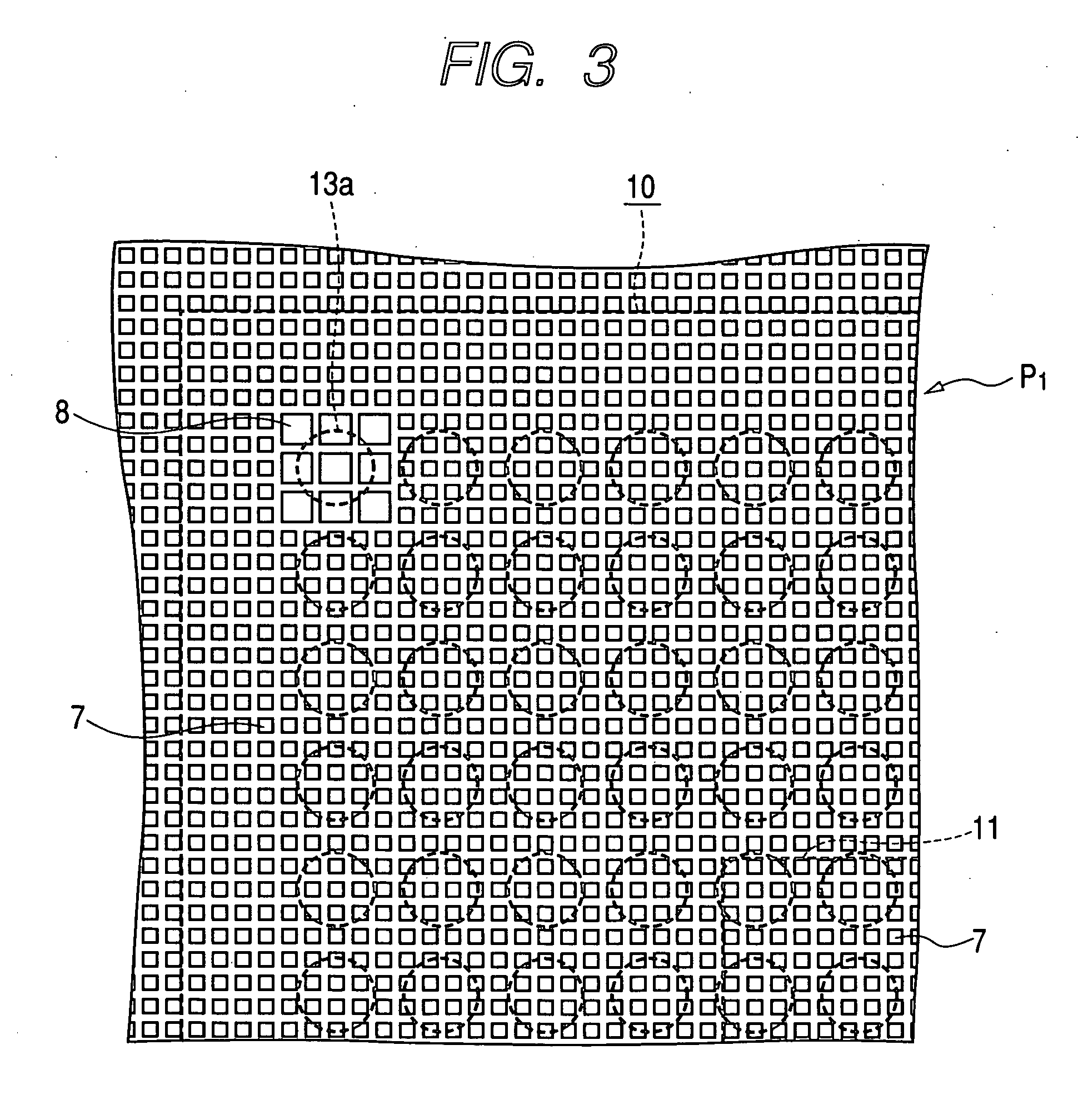Multilayer printed wiring board and multilayer printed circuit board
a printed wiring board and multi-layer technology, applied in the direction of printed circuits, printed circuit stress/warp reduction, high frequency circuit adaptations, etc., can solve the problems of large stress applied to the solder ball, the disconnecting of the joint between the semiconductor device and the printed wiring board, and the cracking of the solder ball. , to achieve the effect of stabilizing the impedance of the wiring and reducing the stress of the solder joint portion
- Summary
- Abstract
- Description
- Claims
- Application Information
AI Technical Summary
Benefits of technology
Problems solved by technology
Method used
Image
Examples
embodiment 1
[0024]FIG. 1 is a sectional view of a multilayer printed wiring board of the Embodiment 1. In FIG. 1, a multilayer printed wiring board P1 is formed of laminated four resin layers 1a, 1b, 1c, and 1d. A first wiring pattern 2 is formed on the interfacial surface between the first resin layer 1a and the second resin layer 1b, a second wiring pattern 3 is formed on the interfacial surface between the second resin layer 1b and the third resin layer 1c, and a third wiring pattern 4 is formed on the interfacial surface between the third resin layer 1c and the fourth resin layer 1d. The first wiring pattern 2 is a ground layer, the second wiring pattern 3 is a signal wiring layer, and the third wiring pattern 4 is a power supply layer. The resin layers 1a, 1b, 1c, and 1d are respectively formed of a glass epoxy resin obtained by reinforcing an epoxy resin with glass cloth.
[0025] Moreover, a plurality of lands 5 are formed on the surface of the first resin layer 1a in the form of an array ...
embodiment 2
[0033]FIG. 4 is a top view showing a first wiring pattern 2 of a multilayer printed wiring board P2 of the Embodiment 2. To simplify the description, the contour of a semiconductor device 10, contour of an IC chip 11, and position of a solder ball 13 are shown by a dotted line. Rectangular openings are formed on the first wiring pattern 2 in the form of a mesh.
[0034] In FIG. 4, a joint portion where a maximum stress due to thermal expansion is generated is a solder ball 13a located at four corners of the solder balls arranged in the form of an array on the semiconductor device 10 shown in FIG. 3 as well as a solder ball 13b located at four corners of the IC chip 11. This is because the thermal expansion coefficient of a semiconductor device is greatly influenced by the IC chip 11 made of silicon, so that a large joint stress is generated also in the solder ball 13b located at four corners of the IC chip 11. In the first wiring pattern 2, a region corresponding to joint portions for...
embodiment 3
[0036]FIG. 5 is a top view showing a first wiring pattern 2 of a multilayer printed wiring board P3 of the Embodiment 3. To simplify the description, the contour of a semiconductor device 10, contour of an IC chip 11, and positions of solder balls 13a are shown by a dotted line. Rectangular openings are formed on the first wiring pattern 2 in the form of a mesh.
[0037] In FIG. 5, a portion at which a joint portion to generate a maximum stress due to thermal expansion is formed is a solder ball located at four corners of the semiconductor device 10 similarly to FIG. 3. In FIG. 5, in the first wiring pattern 2, a mesh opening 8 formed by a plurality of rectangular openings 9a is formed only on a portion corresponding to solder balls located at four corners of the semiconductor device 10. The other regions are constituted of a solid ground pattern 9b.
[0038] Thereby, a stress due to thermal expansion is reduced. Moreover, by forming the rectangular opening 9a into a fine mesh pitch, it...
PUM
 Login to View More
Login to View More Abstract
Description
Claims
Application Information
 Login to View More
Login to View More - R&D
- Intellectual Property
- Life Sciences
- Materials
- Tech Scout
- Unparalleled Data Quality
- Higher Quality Content
- 60% Fewer Hallucinations
Browse by: Latest US Patents, China's latest patents, Technical Efficacy Thesaurus, Application Domain, Technology Topic, Popular Technical Reports.
© 2025 PatSnap. All rights reserved.Legal|Privacy policy|Modern Slavery Act Transparency Statement|Sitemap|About US| Contact US: help@patsnap.com



